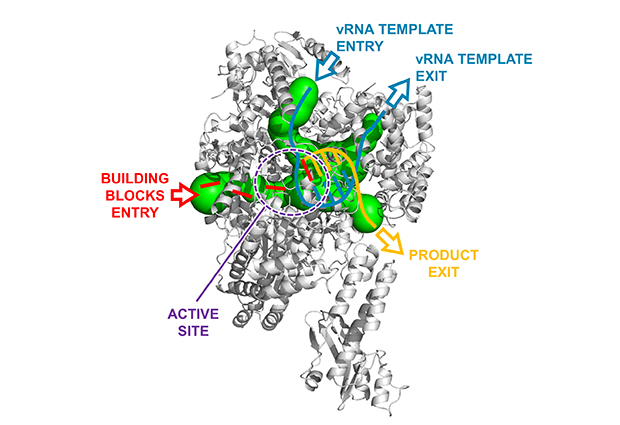It runs in the family
In an article published in Cell, researchers unveil the first detailed 3D-structure of the replication machinery - polymerase - of the La Crosse orthobunyavirus (LACV), a virus which can cause human encephalitis. LACV is in the same broad group of viruses as influenza and the findings show that the LACV polymerase has striking similarities to influenza virus polymerase whose atomic structure was previously determined by the same team.

Stephen Cusack and Juan Reguera from EMBL Grenoble, who jointly led the research, now believe that all viruses within this group are likely to have a very similar polymerase. This opens up the possibility of quicker routes to developing treatments for the diseases they cause.
Many dangerous human viruses, including influenza, Ebola and rabies viruses use RNA as their genetic material instead of DNA; these viruses have a special machine, known as the polymerase, to replicate their RNA genomes. The polymerase carries out two distinct functions: it makes copies of the virus’ genetic material, or viral RNA (vRNA), destined to be packaged into progeny viruses; and it makes viral messenger RNA (mRNA), which are used to make viral proteins by hijacking the host cell protein making machinery.
LACV and influenza viruses belong to the so-called segmented negative-strand RNA viruses, whose members cause diseases including Lassa fever, Crimean Congo haemorrhagic fever, as well as all forms of influenza.
This group of viruses has a very specific way of making their mRNA – they ‘snatch’ a ‘cap’ of genetic material from the host cell mRNA and insert it into their own. This sets them apart from other groups of viruses, but also means that the complex machinery required to do this is likely to be common to them all.
Their polymerases maintain the same structural architecture and carry out replication and transcription of the genome in the same fashion
Piotr Gerlach, who carried out this work for his PhD, explains: “These viruses have evolved separately over millions of years, so they are genetically quite different. Yet their polymerases maintain the same structural architecture and carry out replication and transcription of the genome in the same fashion.”
For both processes, vRNA needs to pass through the polymerase so that it can be copied. Using X-ray crystallography and cryo-electron microscopy, the team were able to identify that both ends of the vRNA attach to the polymerase to create a circle, and then sections of vRNA thread themselves through the polymerase before rejoining the circle again. Depending on whether polymerase is in replication or transcription mode, the vRNA is used as a template to create copies of itself, or – with the addition of the ‘cap’ snatched from the host cell – to create mRNA coding for viral proteins.
The structure of the polymerase clearly shows that the exit and entry points for the template vRNA are close together, allowing it to easily pass through the polymerase and back out again. It also shows that the exit for whatever is produced – whether vRNA copies or mRNA – is on the opposite site of the polymerase, ensuring that no mistaken interactions between template and product occur.
This level of detail has allowed the team to deduce how the polymerase functions in LACV and also give new insight into the influenza polymerase. Work is already under way to develop anti-viral drugs that inhibit the influenza virus polymerase. The team hope that by understanding structural and functional similarities across the whole group, promising compounds could be adapted to other related viruses.



